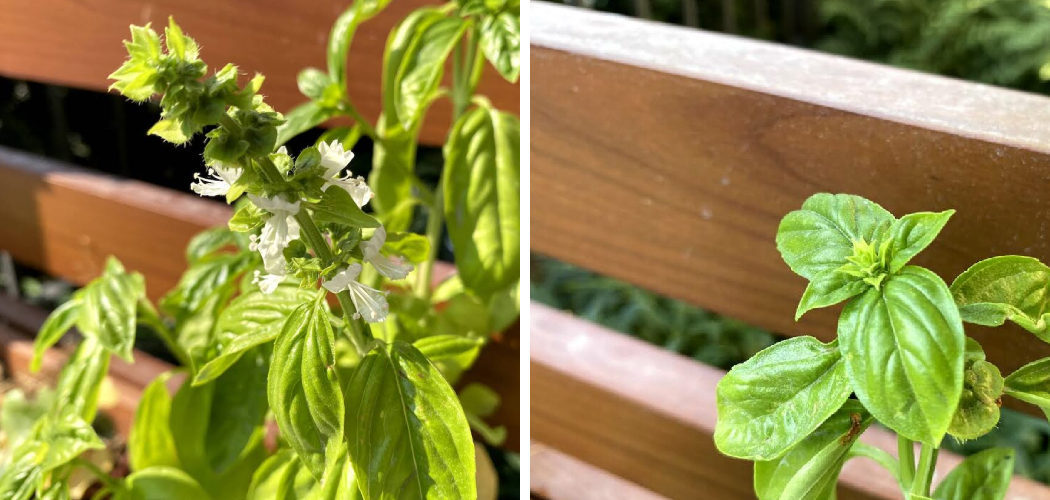To prevent basil from flowering, pinch off the flower buds as soon as they appear. This will help redirect the plant’s energy towards leaf production, prolonging the plant’s life and enhancing its flavor.
Basil is a popular herb known for its aromatic leaves and culinary uses. However, when left to flower, the plant’s flavor diminishes, and it eventually goes to seed, ending its lifecycle. By regularly removing the flower buds, you can maintain a steady supply of fresh basil leaves for a longer period.
Implementing this simple practice will ensure that your basil remains productive and continues to provide you with a fresh and vibrant source of flavor in your dishes.

How to Prevent Basil from Flowering: 5 Easy Guides
1. Understanding The Flowering Of Basil
Basil flowering can hinder plant growth. Understanding why basil flowers is crucial. Several factors influence basil flowering, such as light and temperature requirements. Nutrient imbalances can also trigger flowering. Proper watering practices play a vital role in preventing premature flowering.
By providing the right amount of water, you can help your basil plants focus on leaf growth rather than flowering. Maintaining a balance of nutrients and ensuring optimal light and temperature conditions are also necessary. By following these guidelines, you can prevent basil from flowering and promote robust plant growth.
2. Techniques To Prevent Basil From Flowering
Basil is a popular herb known for its aromatic leaves. To prevent basil from flowering, certain techniques can be implemented. One method is pruning, where you remove the top portion of the plant to encourage bushier growth. Pinching can also be done to remove any existing or developing flower buds.
It is crucial to plant basil at the right time and location, ensuring it receives adequate sunlight and is not overcrowded. Proper spacing between plants allows for air circulation and prevents the plants from competing for resources. Regular maintenance practices, such as harvesting leaves and providing the right amount of fertilizer, help promote leaf growth and discourage flowering.
Additionally, watering techniques should be implemented to keep the soil moist but not overly saturated. By following these techniques, you can keep your basil plants focused on leaf production and prevent premature flowering.
3. Natural Remedies To Prevent Basil From Flowering
Basil is a popular herb that is cherished for its fragrant leaves and culinary uses. Preventing basil from flowering can help maintain its flavor and prolong its lifespan. One natural remedy to discourage flowering is using garlic spray. This homemade deterrent can be made by blending garlic cloves and water, then straining the mixture into a spray bottle.
Applying this spray to the basil plants can help prevent flowering. Another approach is companion planting with basil. Certain plants, like tomatoes and peppers, can inhibit basil flowering when grown together. Additionally, incorporating plants that deter flowering into the garden, such as marigolds and calendula, can be beneficial.
Utilizing organic fertilizers and nutrient-rich amendments can also promote leaf growth and deter basil from flowering. By following these methods and applying them at the appropriate times, basil can be kept from flowering, allowing for a longer harvest of flavorful leaves.
4. Troubleshooting Flowering Basil
Basil plants can be prevented from flowering by addressing nutrient deficiencies, environmental challenges, and extreme weather conditions. Identify symptoms of common deficiencies and provide the necessary remedies. Additionally, manage excessive heat or cold to protect the basil. It is crucial to control pests and diseases that can affect basil plants.
Explore organic methods and remedies to combat infestations. By taking these proactive measures, you can ensure that your basil plants thrive and avoid premature flowering.
5. Harvesting And Using Basil Flavorfully
Timing is crucial when harvesting basil to ensure optimal flavor and aroma. Harvesting techniques and tips play a significant role in preserving the freshness of basil for extended use. There are various methods of drying, freezing, and storing basil leaves to maintain their quality.
To make the most of your basil, get creative in the culinary department. Explore the different ways to use basil leaves in delicious recipes and discover unique serving suggestions. With these strategies, you can prevent basil from flowering and continue to enjoy its delightful flavor throughout the year.
Frequently Asked Questions Of How To Prevent Basil From Flowering
How Do You Stop Basil From Flowering?
To stop basil from flowering, pinch off the flower buds as soon as they appear.
Should I Stop My Basil From Flowering?
No, it’s best to pinch off basil flowers to encourage leaf growth.
Why Is My Basil Starting To Flower?
Basil starts to flower when it is stressed, lacks enough light, or is reaching maturity.
How Do You Keep Basil From Producing All Summer?
To prevent basil from producing all summer, regularly prune the plant by pinching off the top leaves and flowers.
Conclusion
To keep your basil from flowering, it is crucial to understand the reasons behind it. By implementing the appropriate preventive measures, you can ensure that your basil plants focus their energy on leaf production rather than flowering. Regularly pinching off the developing flower buds is the most effective method to prevent flowering.
This encourages the plant to grow bushy and full, providing ample leaves for harvesting. Adequate spacing between plants, proper nutrition, and consistent pruning are also important factors in preventing basil from flowering. Additionally, maintaining a consistent watering schedule and providing adequate sunlight will keep your basil plants healthy and vibrant, further reducing the chance of premature flowering.
By following these simple guidelines, you can enjoy a bountiful harvest of basil leaves throughout the growing season. Happy gardening!

